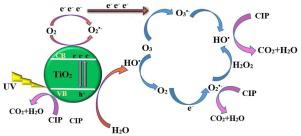当前位置:
X-MOL 学术
›
Process Saf. Environ. Prot.
›
论文详情
Our official English website, www.x-mol.net, welcomes your
feedback! (Note: you will need to create a separate account there.)
Degradation of ciprofloxacin by photocatalytic ozonation process under irradiation with UVA: Comparative study, performance and mechanism
Process Safety and Environmental Protection ( IF 6.9 ) Pub Date : 2021-03-01 , DOI: 10.1016/j.psep.2020.09.041 Esrafil Asgari , Amir Sheikhmohammadi , Heshmatollah Nourmoradi , Shahram Nazari , Mohammad Aghanaghad
Process Safety and Environmental Protection ( IF 6.9 ) Pub Date : 2021-03-01 , DOI: 10.1016/j.psep.2020.09.041 Esrafil Asgari , Amir Sheikhmohammadi , Heshmatollah Nourmoradi , Shahram Nazari , Mohammad Aghanaghad

|
Abstract The photocatalytic ozonation process (O3/UVA/TiO2) was applied for the removal of ciprofloxacin antibiotic (CIP) from aqueous solutions. The influence of various operational factors such as solution pH, initial pollutant concentration, catalyst content, ozone dose and scavengers was studied on the process. The mineralization, biodegradability, kinetic models, catalyst recyclability, electrical energy consumption and cost estimation of the process were also performed. Various techniques of FE-SEM, EDS, FTIR, XRD and UV–vis were applied to characterize the catalyst. The highest CIP removal (98.5 %) was obtained in ozone and catalyst doses of 0.34 g/h and 1.0 g/L, respectively during 15 min reaction time at pH 9.0. The scavenging experiments approved the contribution of hydroxyl radicals ( OH) and superoxide (O2 −) as the main active radical species in the process. The competition effect of various anions on the process efficiency was in the order of chloride > carbonate > bicarbonate > sulfate. The process kinetics followed the pseudo-first-order model. The catalyst efficiency was about 95 % of the original one after 6 recycling steps. It can be concluded that the photocatalytic ozonation process (O3/UVA/TiO2), due to the low reaction time and high removal efficiency, can be considered as a suitable and practical technique for the removal of antibiotics from aqueous solutions.
中文翻译:

UVA照射下光催化臭氧化降解环丙沙星的比较研究、性能和机理
摘要 采用光催化臭氧化工艺(O3/UVA/TiO2)去除水溶液中的环丙沙星抗生素(CIP)。研究了溶液pH值、初始污染物浓度、催化剂含量、臭氧剂量和清除剂等各种操作因素对工艺的影响。还进行了该过程的矿化、生物降解性、动力学模型、催化剂可回收性、电能消耗和成本估算。FE-SEM、EDS、FTIR、XRD 和 UV-vis 等多种技术被应用于表征催化剂。在 0.34 g/h 和 1.0 g/L 的臭氧和催化剂剂量下,在 pH 9.0 的 15 分钟反应时间内获得了最高的 CIP 去除率 (98.5%)。清除实验证实了羟基自由基 (OH) 和超氧化物 (O2 -) 作为该过程中的主要活性自由基物种。各种阴离子对工艺效率的竞争作用依次为氯化物>碳酸盐>碳酸氢盐>硫酸盐。过程动力学遵循拟一级模型。经过 6 个循环步骤后,催化剂效率约为原始催化剂的 95%。可以得出结论,光催化臭氧化工艺(O3/UVA/TiO2)由于反应时间短、去除效率高,可以被认为是一种适用于去除水溶液中抗生素的实用技术。过程动力学遵循拟一级模型。经过 6 个循环步骤后,催化剂效率约为原始催化剂的 95%。可以得出结论,光催化臭氧化工艺(O3/UVA/TiO2)由于反应时间短、去除效率高,可以被认为是一种适用于去除水溶液中抗生素的实用技术。过程动力学遵循拟一级模型。经过 6 个循环步骤后,催化剂效率约为原始催化剂的 95%。可以得出结论,光催化臭氧化工艺(O3/UVA/TiO2)由于反应时间短、去除效率高,可以被认为是一种适用于去除水溶液中抗生素的实用技术。
更新日期:2021-03-01
中文翻译:

UVA照射下光催化臭氧化降解环丙沙星的比较研究、性能和机理
摘要 采用光催化臭氧化工艺(O3/UVA/TiO2)去除水溶液中的环丙沙星抗生素(CIP)。研究了溶液pH值、初始污染物浓度、催化剂含量、臭氧剂量和清除剂等各种操作因素对工艺的影响。还进行了该过程的矿化、生物降解性、动力学模型、催化剂可回收性、电能消耗和成本估算。FE-SEM、EDS、FTIR、XRD 和 UV-vis 等多种技术被应用于表征催化剂。在 0.34 g/h 和 1.0 g/L 的臭氧和催化剂剂量下,在 pH 9.0 的 15 分钟反应时间内获得了最高的 CIP 去除率 (98.5%)。清除实验证实了羟基自由基 (OH) 和超氧化物 (O2 -) 作为该过程中的主要活性自由基物种。各种阴离子对工艺效率的竞争作用依次为氯化物>碳酸盐>碳酸氢盐>硫酸盐。过程动力学遵循拟一级模型。经过 6 个循环步骤后,催化剂效率约为原始催化剂的 95%。可以得出结论,光催化臭氧化工艺(O3/UVA/TiO2)由于反应时间短、去除效率高,可以被认为是一种适用于去除水溶液中抗生素的实用技术。过程动力学遵循拟一级模型。经过 6 个循环步骤后,催化剂效率约为原始催化剂的 95%。可以得出结论,光催化臭氧化工艺(O3/UVA/TiO2)由于反应时间短、去除效率高,可以被认为是一种适用于去除水溶液中抗生素的实用技术。过程动力学遵循拟一级模型。经过 6 个循环步骤后,催化剂效率约为原始催化剂的 95%。可以得出结论,光催化臭氧化工艺(O3/UVA/TiO2)由于反应时间短、去除效率高,可以被认为是一种适用于去除水溶液中抗生素的实用技术。











































 京公网安备 11010802027423号
京公网安备 11010802027423号